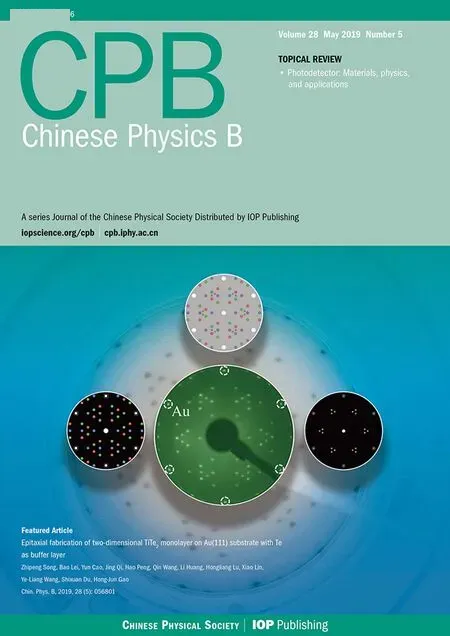Low tem perature Pmmm and C2/m phases in Sr2CuO3+δ high temperature superconductor*
Hai-BoWang(王海波),Zhen-Lin Luo(羅震林),Yuan-Jun Yang(楊遠(yuǎn)俊),Qing-Qing Liu(劉清青),Si-Xia Hu(胡思俠),Meng-Meng Yang(楊蒙蒙),Chang-Qing Jin(靳常青),and Chen Gao(高琛),4,?
1Tonghua NormalUniversity,Tonghua134002,China
2NationalSynchrotron Radiation Laboratory and SchoolofNuclearScience and Technology,
University ofScience and Technology ofChina,Hefei230026,China
3Institute ofPhysics,Chinese Academy ofSciences,Beijing 100080,China
4CASKey Laboratory ofMaterialsforEnergy Conversion and Collaborative Innovation CenterofChem istry forEnergy Materials,University ofScience and Technology ofChina,Hefei230026,China
(Received 30November2018;revisedmanuscript received 12March 2019;published online 4April2019)
Keywords:resonantx-ray diffraction,x-ray absorption f ine structure,modulated phase,superconductivity
1.Introduction
Despite the discovery of high-temperature superconductors more than two decades ago,the relationship between their superconductivity and theirm icrostructure still remains a mystery.[1–3]With grow ing evidence for the existence of different kinds of microstructures in the high Tcsuperconducting cuprates,complex microstructures and their evolution were considered to be highly correlated with the superconductivity of the cuprates.[4–11]The richmodulated phases in the cuprates with either oxygen interstitials or vacancies were a case in point,themost striking feature was the appearance of chargemodulation generally coexisting and playing a suppressive role in superconductivity of doped La-214 cuprates,such as La2-x-yNdySrxCuO4,La2-xBaxCuO4,and La1.8-xEu0.2SrxCuO4. The competitive characteristics between superconductivity and charge order have been reported in YBa2Cu3Oy.The chargemodulation seemed to play a key role in affecting the superconductivity of cuprates.Furthermore,the anomalous lattice response to the onset of charge modulation and Tcwas also reported to be important in explaining the superconductivity of cuprates.Several recent workson doped La-214 cuprate superconductors revealed the intimate relationship among the chargemodulation,local lattice f luctuation,and high-Tcsuperconductivity.[12–20]
Sr2CuO3+δis a single-CuO2-layer cuprate with sim ilar structure to La2CuO4(Fig.1(a)).With La replaced by Sr which contributed one electron less to the system,a signif icantamountofoxygen vacancieswere introduced to stabilize thematerial,which could only be grown under high pressure.Surprisingly,evenwith signif icantdefects in thesystem,when compared with La2CuO4,Sr2CuO3+δshowedmuch higher Tc(maximum reportedwas95K).In thepast few years,greateffortsweremade to reveal the evolution of the superstructures and its relationship with the superconductivity in Sr2CuO3+δ.Liu etal.reported the coexistenceof C2/m and Fmmm phases in as-synthesized Sr2CuO3+δ.[21,22]They also found that the C2/m phase transited to the Cmmm and Pmmm phaseswhen the annealing temperature decreased to 150°C and 250°C,and the corresponding Tcshifted from 75 K to 89 K and 95 K,respectively.Due to no change of the Fmmm phasewith the shiftof Tc,the Fmmm phasewasbelieved to have no correlationwith thesuperconductivity.However,Wang etal.claimed that the Fmmm phase was superconductivity-related because only the Fmmm phase was observed in Sr2CuO3+δsample annealed atdifferent temperaturesall the time,andmoreover,its coherent length varied with the annealing temperature.[23]Since these studieswere all carried outat room temperature,the phaseevolution at low temperature isconsideredmore important to understand the superconductivity of Sr2CuO3+δ.
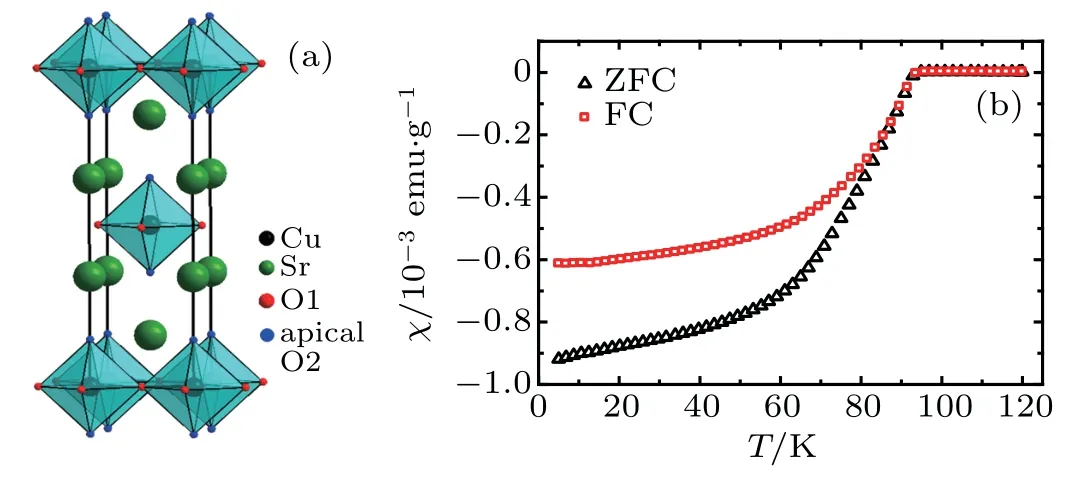
Fig.1.(a)A sketch of Sr2CuO3+δunit cell in space group I4/mmm.This wasused as the average structure in the follow ing structural ref inement.(b)Temperature dependence of the DCmagnetic susceptibility in both the zerof ield-cooling and f ield-coolingmodes for Sr2CuO3+δ,revealing the superconducting transitionwith T c~95 K.(Ref.[18]copyright).
2.M ethods
To follow up the phase evolution of Sr2CuO3+δat low temperature,systematic temperature-dependent x-ray diffraction(XRD)and x-ray absorption f inestructure(XAFS)studies were carried outat Cu K edge.The results showed that two low-temperature phases,Pmmm and C2/m,emerged around 120 K and 60 K and the formermay highly correlated with the superconductivity because it appeared around the superconducting critical temperature.
Sr2CuO3+δpolycrystalline specimenswithδ=0.4were fabricated by using high temperature high pressure solid state synthesistechnique.The temperature-dependentDCmagnetic susceptibility curve showed a superconducting transition at 95 K.Details of the sample preparation and magnetic susceptibilitymeasurementhave been reported in Ref.[24].The temperature-dependentsynchrotron radiation x-ray diffraction and extended x-ray absorption f ine structure(EXAFS)at Cu K edge were carried outwith beam lines of 14B1 and 14W 1 at the Shanghai Synchrotron Radiation Facility.The photon energy(x-ray wavelength)was calibrated with a Cu foil.
3.Resultsand discussion
As shown in Fig.2,the XRD patterns of Sr2CuO3+δat different temperatures(13 K,35 K,50 K,65 K,70 K,75 K,80 K,90 K,95 K,100 K,115 K,120 K,130 K,160 K,190 K,230 K,300 K)converted from the Debye ringswere recorded by a two-dimensional x-ray detector.The data was processed with FIT2D software.Figures 2(a)and 2(b)show the collected XRD patternsat8.500 keV(far below the Cu K edge)and 8.990 keV(in the Cu K edge range),respectively.Details of the Debye rings can be found in the supplementary materials.Except for the diffraction peaks from the reported Fmmm phases,[21,22]three new diffraction peakswere found when the temperature decreased to around 120 K and 60 K.This result indicates(through indexing)that two new modulated phases developed at low temperature.To determine thesymmetry of the low temperaturephases,indexing of the diffraction peakswas carried outwith results listed in Table 1.The space groups(parameters of unit cell)determ ined from the indexing are Pmmm(ap=5.883?A,bp=16.020?A,cp=6.080?A)and C2/m(ac=16.800?A,bc=6.660?A,cc=9.881?A,β=119.5°),respectively.The Pmmm phaseappeared ataround 120 K,while the C2/m phase came out from about60K.Thevolumeof the Pmmm phasemodulation structurewaswhile the volume of the C2/m phasemodulation structurewas3Here,atand ctare the lattice constants in theunit cell.At the same time,thediffraction intensity of the Pmmm phaseappearing at 120K wasstronger than thatof the C2/m phaseat60K.More importantly,we found that the diffraction peaks(5.48?A and 3.26?A)from the low temperature Pmmm phase showed up only in Cu K absorption edge range(anomalous scattering),while diffraction peaks from other phases showed no obvious intensity change with photon energy.This indicates that the modulation in the low temperature Pmmm phasewaspurely an electronic behaviorof the Cu valence state,whilemodulation in other phases should come from the displacement of ions or ordering of oxygen vacancy.In other words,themodulation in the low temperature Pmmm phasem ightcome from Cu charge ordering,such as charge density wave of Cu 3d electron.This result coincided with the recent reports on La-214 cuprates thata charge density waveappeared in the proximity of Tc.[25–30]
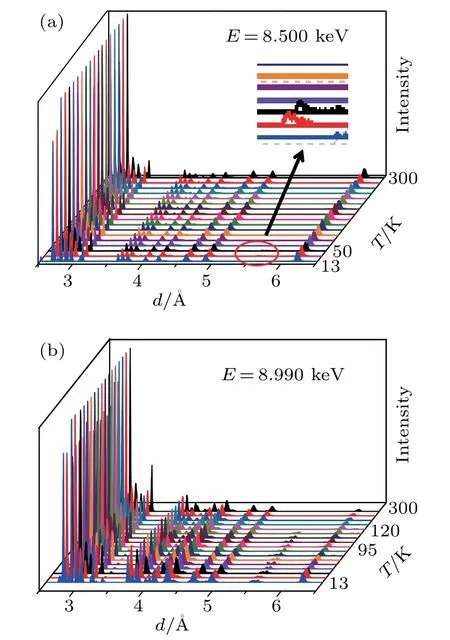
Fig.2.X-ray diffraction result of Sr2CuO3+δas function of temperatureand incidentx-ray energy.(a)and(b)Thex-ray diffraction patterns obtained atvaried temperatureswith x-ray energy of(a)8.500 keV and(b)8.990 keV.Somemodulated structures emerge in the low temperature region.
Coincidently,the local lattice f luctuation on Cu site has been reported at the onsetof charge density wave.[26–30]The coincidence indicates that theelectron–lattice interaction isan importantelement forsuperconductivity of doped cuprates.
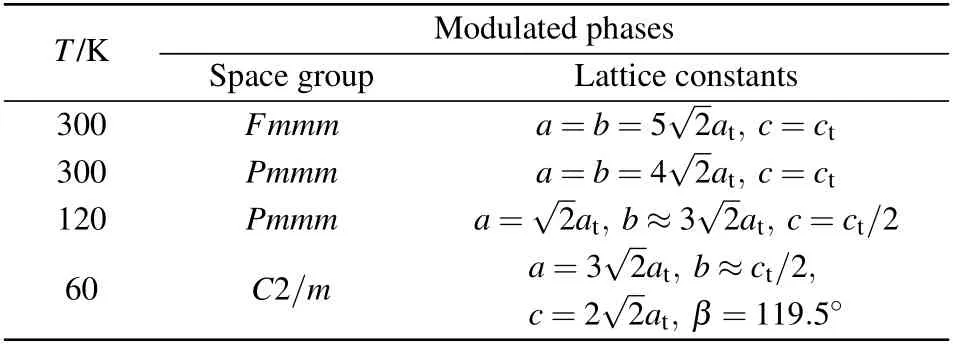
Table 1.Themodulated phases of Sr2CuO3+δsuperconducting specimen obtained from indexing the diffraction peaks.The lattice parameters for tetragonal structure Sr2CuO3+δare a t=b t=3.785?A and c t=12.425?A.
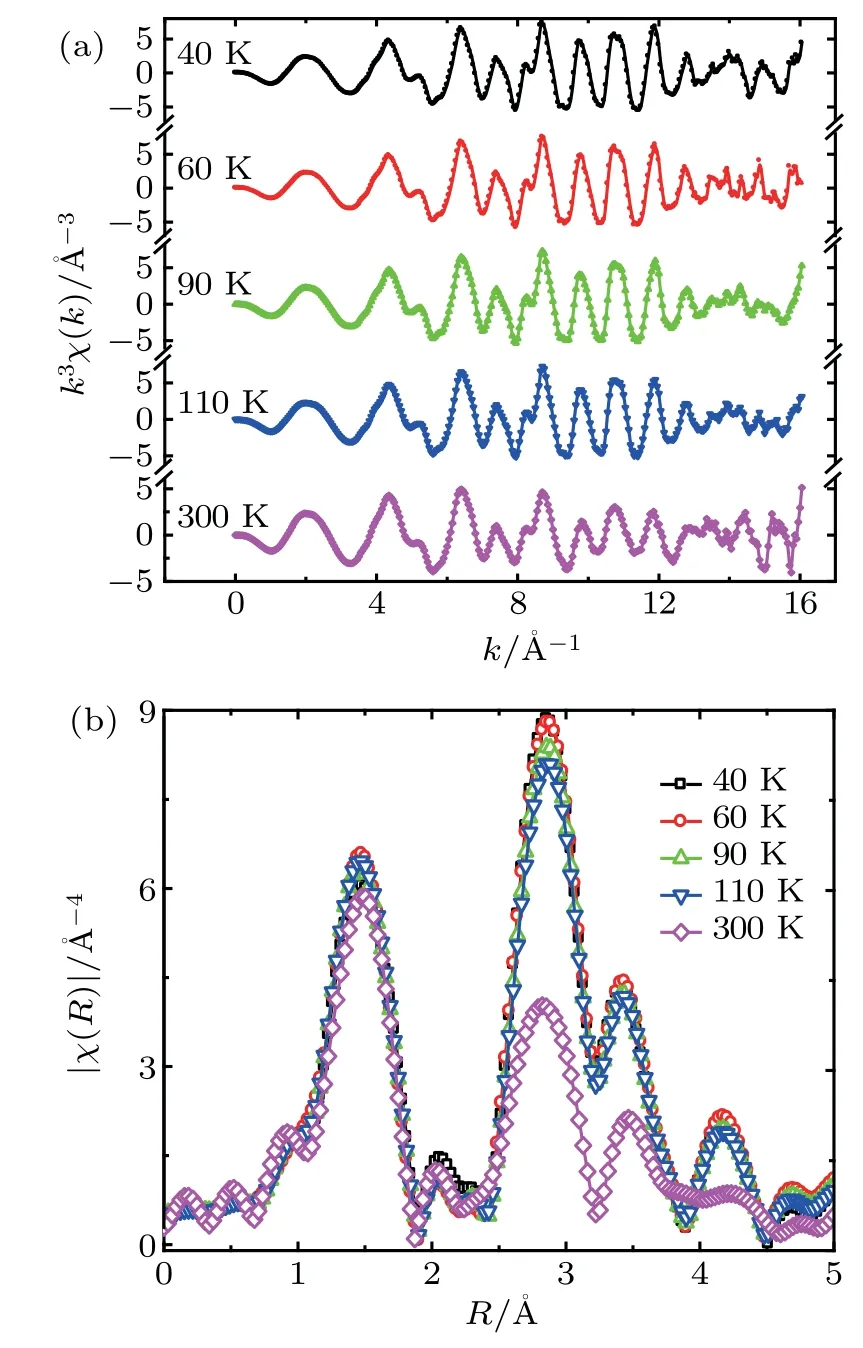
Fig.3.X-ray absorption f ine structure spectroscopy resultof Sr2CuO3+δas a function of temperature.The temperature dependence of Cu K-edge(a)EXAFS oscillations inmoment space(weighted by k3)and(b)FTmagnitude function in realspace for Sr2CuO3+δ.
To verify if this local lattice f luctuation around Cu site correlated with the modulation of Cu valence state in Sr2CuO3+δ,temperature-dependent EXAFSmeasurement at Cu K-edge was performed.Figure 3(a)shows f ive representative k3-weighted EXAFS oscillations of Sr2CuO3+δat the temperaturesof 300 K,115 K,90 K,60 K,and 40 K;and the corresponding radial-structure-functions(Fourier transform of the EXAFS oscillations)are shown in Fig.3(b).Details for the EXAFS data processing can be found in the supplementary materials.The f irst three peaks in Fig.3(b)can be attributed to theCu–O,Cu–Sr,and Cu–O–Cu coordinations,respectively.The location of the peak was determ ined by the coordination distance,and the intensity of the peak was determined by the coupling strength of the coordination bonds.According to the coordination structure around Cu atom,the O atoms for CuO6octahedron were nearest to the Cu atom,the f irstpeak in Fig.3(b)was due to the Cu–O coordination.Thesecond peakwasdue to theCu–Srcoordination.The third peak came from the Cu–O–Cu coordination.
In the La-214 cuprates,for example,La2-xSrxCuO4,La1.48Sr0.12Nd0.4CuO4,La1.875Ba0.125CuO4,XAFS studies revealed an upturn on the Debye–Waller factor around Tc.[19,25,26]This upturn was interpreted as the local lattice instability.[19,25,26]Sim ilar behavior was also observed in Sr2CuO3+δ.As shown in Fig.4(a),the Debye–Waller factor of the Cu–O coordination,as the function of the temperature,was denoted as themean-square relative displacement of O around Cu.Itwasbelieved to be relevantwith low temperature modulated phases in doped 214 cuprates.[19,20,31–34]Asshown in Fig.4(a),theanomalousupturnsappeared around 115K and 60K as the temperaturedecreased.Combinedwith theanomalous XRD result,it isbelieved that the upturn is caused by the critical f luctuation of the phase transition.[33,34]The Debye–Waller factorwas ameasure of themean-square relative Cu–O bond.[33,34]At the critical temperature of phase transition,nucleation of new phase caused lattice f luctuation and a sudden increase of Debye–Waller factor.In order to observe the instability clearly,weperformed f itting for the temperaturedependentDebye–Waller factorof Cu–O bond of Sr2CuO3+δby using the Debyemodel.The f itting curve is shown as the circles in Fig.4(a).The clear difference between experimental resultand f itting can be seen,which was attributed to the occurrence of local lattice instability below 115 K.However,as soon as the phase transition f inished,the Debye–Waller factor returned to the normal value,itm ightbe attributed to the cooper pairing.
The anomalous tendency was also observed in x-ray absorption near edge structure(XANES).The upper inset of Fig.4(b)shows a typical Cu K-edge XANES of Sr2CuO3+δ(δ=0.4)at 20 K and its best f itting result.For CuO6octahedral coordination,there are four small peaks in XANES marked with A1,A2,B1,and B2.A1 and B1 originated from the 1s→4pzand 1s→4px,ytransitions,which came from the multiple scattering of ejected photoelectronsby oxygen atoms in apical and in-plane sites,respectively.A2 was caused by the scattering of photoelectrons from Sr atoms in the rocksalt layer,while B2 includedmultiple scattering contribution.Factor R=(b1-a1)/(b1+a1),where a1and b1are the intensitie of A1 and B1 peaks,could be used to represent the local lattice f luctuation and electronic density inhomogeneity around Cu atoms.[33,34]The temperature dependence of R for Sr2CuO3+δis shown in Fig.4(b),the value increased monotonically with the decrease of temperature.This indicates that the charges transferred gradually from the apical site to in-plane site.This resultwas in accordance with the charge transfer picture of other layered cuprates.Sim ilar to the evolution of Debye–Waller factor of Cu–O bond,the R factor also showed two anomalous drops at about 60 K and 115 K,indicating signif icant local lattice distortion.Due to the strong coupling interaction between Cu and O in CuO2plane,the charge density of Cu ions can be easilymodulated by local lattice instability.The inhomogeneouschargedensity distributionmay be the origin of the Pmmm modulated phase at low temperature.Furthermore,exactcoincidencesbetween the startof the f irstglitch(~115 K)and the formation of the low temperature Pmmm phase,between theendpoint(~95K)and thesuperconducting transition temperature Tcwere found.Theabove resultssuggested that the Pmmm phasemay be the superconducting related phase and electron–lattice interaction m ight play a key role in affecting the superconductivity of Sr2CuO3+δ.

Fig.4.(a)Temperature dependence of Debye–Waller factor of Cu–O coordination in Sr2CuO3+δ,show inganomalouschangearound 115K and 60K.The circles in the Fig.4(a)are the f itting resultusing Debyemodel.(b)Temperature evolution of the peak intensity ratio R=(b1-a1)/(a1+b1)obtained from the XANESspectra of Sr2CuO3+δ,also show ing clear changes around 115 K and 60 K.The inset is a typical Cu K-edge XANES of Sr2CuO3+δ(δ=0.4)at20 K and itsbest f itting result.
4.Conclusion
In summary,we reported two low temperature phases Pmmm(120 K)and C2/m(60K)in layered cupratehigh temperature superconductor Sr2CuO3+δ(δ=0.4).The Pmmm phasewas suggested highly correlated with the superconductivity.Strong charge density redistribution and local lattice f luctuations around Cu site occured with the decrease of temperature.The coincidence between the behavior of local lattice instability and Pmmm modulated phase indicated that the electron–latticeinteraction could neverbeneglected forunderstanding the superconductivity of Sr2CuO3+δ.
——敏感的皮膚
- Chinese Physics B的其它文章
- Photoinduced phase transitions in two-dimensional charge-density-wave1T-TaS2*
- Low-tem perature grow th of large-scale,single-crystallinegrapheneon Ir(111)*
- Epitaxial fabrication of two-dimensional TiTe2 monolayer on Au(111)substratew ith Teasbuffer layer*
- Isotopeeffectand Coriolis coup ling effect for the Li+H(D)Cl→LiCl+H(D)reaction*
- V ariationaland diffusion M onte Carlo simulationsof a hydrogen molecular ion in a sphericalbox*
- General way to def ine tunneling time*

